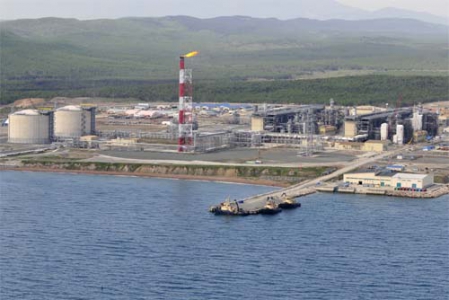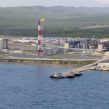
Russia Sees Sakhalin-Japan Energy Projects as Bargaining Tool
Publication: Eurasia Daily Monitor Volume: 9 Issue: 222
By:

Russia’s gas monopoly, Gazprom, has apparently ruled out the possibility of building a subsea Sakhalin-Japan natural gas pipeline. However, the continuation of talks on this ambitious project is thought to remain a valuable bargaining instrument in Russia’s difficult negotiations with China on gas prices.
On November 8, the head of Gazprom’s representative office in Sakhalin, Vladimir Kozlov, announced that the gas giant was yet to make any formal decision on Japan’s suggestions to consider the pipeline project. On November 4, the Japanese newspaper Asahi claimed that Japanese companies were prepared to invest $5 billion in the construction of a 1,400-kilometer gas pipeline with a capacity of 16–20 billion cubic meters (bcm) from Sakhalin to Japan’s Ibaraki Prefecture. The project would involve the gas pipeline from Prigorodnoye Port in southern Sakhalin to the island of Hokkaido, then to the south along Japan’s eastern coast through the Aomori, Iwate, Miyagi and Fukushima Prefectures. Tokyo Gas, Japan Petroleum Exploration (JAPEX) and Nippon Steel & Sumikin Engineering reportedly indicated interest in the project (Interfax, SakhalinMedia, November 8–12).
In May 2009, Gazprom signed a memorandum of understanding (MOU) with Japan’s Natural Resources and Energy Agency, Itochu Corp., and Japan Petroleum Exploration Co. to prepare a feasibility study on future gas supplies to Japan and other Asia-Pacific countries (see EDM, May 17, 2011).
However, earlier this year, Gazprom pledged to abandon the Sakhalin-Japan pipeline project. On June 29, Gazprom CEO Alexei Miller announced that after considering several possible routes, the company found the pipeline project economically and technically unjustified. Gazprom would focus on LNG supplies to Japan, he said. The Russian energy giant’s executives had previously noted significant seismic risks associated with this pipeline project (RBC, Rusenergy, June 29).
Yet despite Gazprom’s apparent reluctance, the Japanese continued to insist that the Sakhalin-Japan gas pipeline could eventually prove feasible. On September 26, executives of Japan Pipeline Development & Operation, Inc. (JPDO), speaking at a conference in Yuzhno-Sakhalinsk, asserted that the pipeline project remained technically possible and economically viable (Prime, September 26).
The continued discussion of projects to supply energy resources to Japan could be used to put pressure on China, Izvestia daily commented on November 12. Japan currently faces energy shortages and could become a better market for Russian energy resources than China, the daily noted.
In August, Japanese officials sent a letter to the Russian energy ministry and suggested renewing discussions on the Sakhalin-Japan pipeline project, according to Izvestia. Gazprom’s CEO Miller was expected to discuss this project during a visit to Japan on November 27–29, the daily wrote. However, Gazprom may prefer to focus on LNG exports in the Far East rather than building the Sakhalin-Japan pipeline, the Russian paper commented (Izvestia, November 12).
The pipeline project is also understood to involve political risks as Moscow has been refusing to discuss a return to Japan of four islands, Kunashir, Iturup, Shikotan and Habomai, known as the Southern Kurils in Russia and the Northern Territories in Japan. Moscow has consistently dismissed Japan’s insistence to return all four islands. The bilateral political ties reached new lows after Russia’s top officials traveled to Kunashir in late 2010 and mid-2012, sparking vocal protests in Tokyo (Voice of Russia, Interfax, July 3). But the Kremlin has kept dismissing Japanese protests.
In recent years, Russian officials have repeatedly encouraged Japanese investment in energy and invited Japanese companies to join the East Siberia-Pacific (ESPO) oil pipeline and the Sakhalin-Khabarovsk-Vladivostok gas pipeline projects. Russian officials also indicated plans to build a major petrochemical complex in Russia’s Far Eastern regions, and invited Japanese businesses to invest in these projects. Yet despite repeated Russian invitations, Japanese businesses have largely refrained from taking part in Russia’s programs to develop Far Eastern energy infrastructure, including ambitious pipeline projects (see EDM, October 15).
Apart from the Sakhalin-Japan pipeline project, the Russian government also ordered the energy ministry to review an earlier project, designed to increase electricity supplies to Japan, South Korea, China and Mongolia. The project, known as the “Asian Super Ring,” first surfaced back in 1998. It was supposed to export surplus electricity, generated by Siberian hydropower plants. The pre-feasibility study of the energy link was done back in 1999–2000, and the project was estimated to cost $9.6 billion. However, this year the Russian energy ministry reportedly suggested starting the Asian Super Ring project by building an electricity transmission line from Sakhalin to Japan. The talk about the Asian Super Ring and the Sakhalin-Japan pipeline project was apparently meant to put some extra pressure on Beijing in the continued negotiations on the price of Russian energy supplies to China (Vostochno-Sibirskaya Pravda, November 16; https://english.pravda.ru/russia/economics/13-11-2012/122794-russia_japan-0/).
As Tokyo was slow to respond with binding investment agreements for the Russian Far Eastern projects, the Kremlin evidently became upset by Japan’s reluctance. Subsequently, Gazprom withdrew its support of the Sakhalin-Japan pipeline project. But Russia’s gas giant remains slow to announce any formal decision on the pipeline, presumably preferring to keep it as a bargaining chip in Russia’s gas talks with China.




